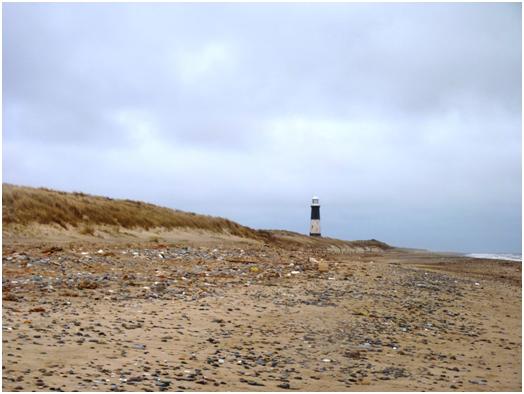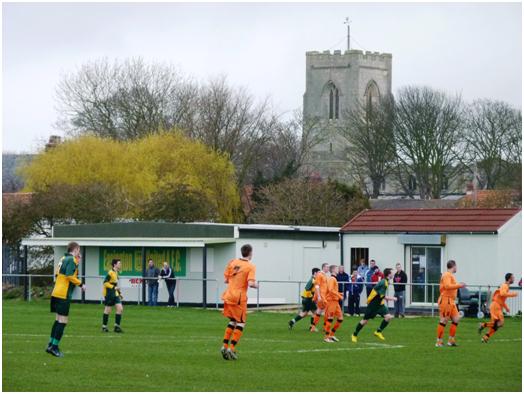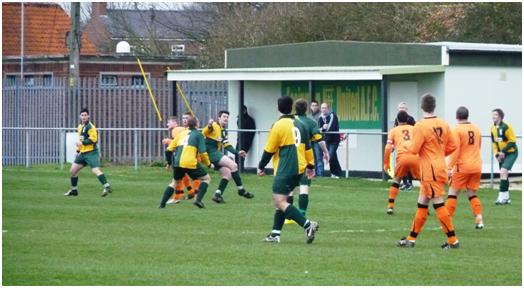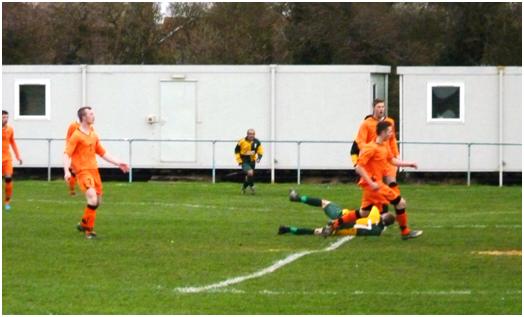Only the Lonely.
At some of its edges, the countryside of England gives away meekly to the sea, without dramatic cliffs, or sandy beaches, the land just rolls away. The line between land and sea is obscured, but the sea is winning. It is estimated that since roman times, the boundary has retreated inland by some three miles, with no less than 23 villages disappearing into the gray waters of the North Sea.
The advice therefore is not to buy a holiday cottage here. If you like the area, take out a lease but keep it short!
I arrived in Easington after driving for some thirty minutes on smaller roads, after the finish of the dual carriageway that cuts a swathe between Hull and the Humber. There was no sign of activity at the football ground, but this was not surprising, over two hours before kick-off. And so I drove on to Spurn point. This is a narrow spit of land that reaches down to enclose nearly half of the mouth of the Humber. Generally it is sand dunes, bound together by rough grasses, with a narrow paved road on the inland side. In places this is only a few yards wide, and the effects of wind and wave mean that it can move over the years. As well as the roadway, there were a few signs of ancient tram lines (first laid down during the first World War, and used somewhat unusually, by bogies with sails). The routing shows the changes over the years, as the rail line, used until around 1950 disappears under the dunes, and may in places be lost to the sea. Certainly the terminus at Kilnsea (the land end) has been lost to the waters.

Spurn Point, Beach and Lighthouse.
The projection into the river mouth, which is formed from some of the materials worn away from further north along the Holderness coast, goes on for around three miles. At the end, there is a more substantial hill, which is used as a base for lifeboats and harbour pilots. The whole area is a nature reserve, and the beaches are free for walkers. From the car park at the end of the road, I walked around the point from the Humber side, and then clambered over the sand dunes to return to my car. A walk that consumed a little under an hour of my time. The contrast between the two sides of the peninsular is impressive. On the Humber side, one is sheltered from the winds, and being a low tide, there is a stillness about the place, and long, low mudflats. As one rounds the point, you are walking into the storm, (and this was a relatively nice day). The wind cuts into you and the waves of the North sea angrily proclaim that they will soon consume the beach, and possibly the whole of the headland. Apart from the natural splendours, and the now ruined wooden breakwaters, that display a vain effort to work, Canute like against the forces of the sea, it is remarkable how much human debris is to be found washed up on this side. Plastics, old fishing nets and even a calor gas cylinder litter the area.
For a football team in this area, it is always going to be about the journey even in the local, Humber Premier League, a team out near the cost will have to travel over 20 miles to play most of their opponents, grouped around the city of Hull. When it was formed back in 2000, merging the best of local leagues, there may have been a dream that the Humber Premier League could take a position as a Step 7 league, and promote to the Northern Counties (East). It quickly became clear that this was not going to be the case the lack of facilities in this league meant there were few candidates, even when the teams felt they could make the step.
Hence, the Humber Premier League has had to accept that its status is actually at Step 9, but there is a shortage of suitable Step 7 and 8 leagues in this area. The West Riding of Yorkshire has two competing leagues, and Sheffield has another, but for clubs both to the North and South of the Humber, the only solution appears to be the geographically unsuitable Central Midlands League, which has its indistinct centre around Nottinghamshire and Derbyshire. Still, two clubs made the step in 2008, and Easington United joined them a year later. Westella and Willerby have now been promoted to the oddly named Supreme Division, (the Step 7 division of the CML), while Easington United and Hutton Cranswick United are in the Premier Division (Step 8). It is 44 miles between the two for the “derby” clash, and for Easington’s second shortest trip, to Thorne, they have to travel 58 miles. All the rest are more than 70 miles away, with three over 100 miles.
I returned to the football ground around 45 minutes before the start, and I was immediately worried by how quiet the place was only a few cars in the car park and no one on the pitch. Still, on wandering in, I found the tea bar open, and willing to sell me a cuppa (50p) and a programme (£2). The referee was also enjoying his tea, but it would be at least 15 minutes before the away side appeared. The fields are enclosed (just), but no admission charge is made, except by programme. Something obviously has to be said about the programme. It is labelled as the league’s programme of the year for 2009/10, and it is hard to imagine that it is not in competition to hold the title. It is both interesting and informative, with surprisingly few of its 24 pages given over to advertising. Sadly, for all the efforts that go into the production, I counted only around 30 people in the crowd to read it.

I asked about how a club like this operates. The players are all amateurs, (I was told that not even expenses are paid), and come from Easington, other local villages and some from Hull itself. A minibus carries them to away matches, and costs £150 each time. There are only 15 teams in the league, but that is partly due to two withdrawals during the season. It is possible that Easington has made one or two wasted trips, for matches now expunged from the table. I also wanted to know if they felt there was a real benefit to playing in the Central Midlands, as opposed to the Humberside League. The reply was that while the best clubs in the Humberside are as good as those they play in the CML, the lesser clubs are far weaker, and by playing in the CML, they are promised a competitive match every week.
Certainly, the game I saw bore this out, but then the visitors, Yorkshire Main are one of the better sides with only one league defeat all season. They are fourth in the league, but a combination of cup successes and worse luck than some with the weather means ‘Main’ have nine games in hand over the league leaders. The ground is very exposed, with two buildings on the south side, providing the dressing rooms and tea bar, and a little shelter part supported from the dressing room building that provides the back wall. A concrete path only extends to the half way line on this side, while permanent railings surround most of the pitch. A sharp East Wind was blowing off the coast, and down the pitch from end to end. Easington attacked into the wind in the first half and took the lead after just 13 minutes when Chris Frost dove to meet a cross from the left wing.

After this, it was end to end stuff, and quite surprising that no more goals were scored. Despite having the league’s leading scorer, Curtis Walker playing behind the front pair at the top of a diamond midfield, Main did not make the most of their midfield domination, while Easington were quick to use the extra width given by the opposition formation with Frost continually catching the eye, and Gavin Thurkettle also impressing.

Chris Frost (7) dives to score the only goal of the game.
Next season, the Central Midlands League will reformat itself into two parallel divisions. This is a move that will give some help to Easington, in so far as a boundary line between North and South divisions will be drawn. Still, all the Yorkshire clubs will be in the Northern section, including those around Sheffield, and possibly some of those in North Derbyshire. There is at least one more Humberside club applying, (AFC Hull), and the changes will also mean that Easington will again play Westella and Willerby, currently in the higher division.
I have heard that Tideswell United have also applied, but at least Easington should be spare travelling high into the peak district to play current members of the Hope Valley League. Most of the other names I have heard as possible new members are in either the Notts Senior, or Midland Regional Alliance, strictly in the south. The question for further ahead is how the FA treats the other leagues in Yorkshire. The FA appears to have promised Step 7 status to both Central Midlands Divisions for next season, with promotion available from the North to the Northern Counties (East), and from the South to the East Midlands League. If the FA gives the same status to the West Riding, West Yorkshire and Sheffield leagues, then the Humberside teams will still need to pass through other leagues areas for some matches, while if the FA tells these leagues that they are to be Step 8, and encourages clubs to step up, the CML’s northern section could be more of a Yorkshire League, strung out along the M62 motorway